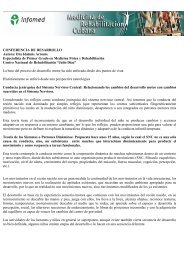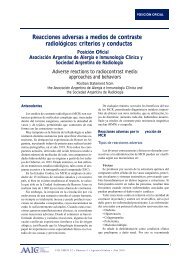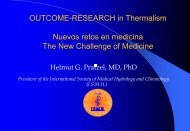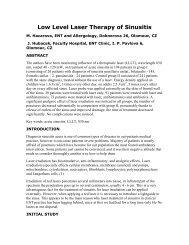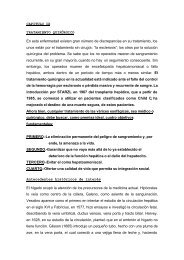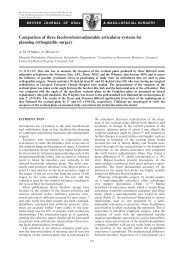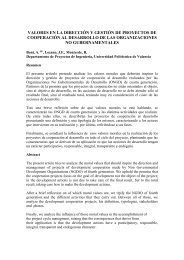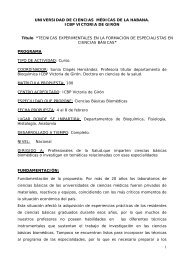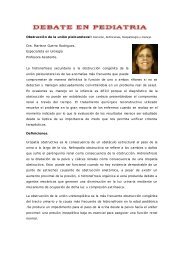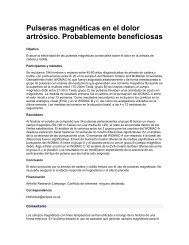pharmacology of medicinal plants and natural products
pharmacology of medicinal plants and natural products
pharmacology of medicinal plants and natural products
You also want an ePaper? Increase the reach of your titles
YUMPU automatically turns print PDFs into web optimized ePapers that Google loves.
MEDICINAL PLANTS (NATURAL PRDUCTS)<br />
S89<br />
action may be at the peripheral level by potentiating<br />
insulin sensitivity 86 .<br />
Hot water extract <strong>of</strong> Camellia sinensis (Black tea leaf)<br />
significantly reduced the blood glucose level <strong>and</strong> was<br />
found to possess both preventive <strong>and</strong> curative effects<br />
in streptozotocin induced diabetic rats 87 .<br />
The leaf extract <strong>of</strong> Azadirachta indica had no effect<br />
per se, on the peripheral utilization <strong>of</strong> glucose (determined<br />
by intravenous glucose tolerance tests) <strong>and</strong><br />
on hepatic glycogen in normal <strong>and</strong> streptozotocin<br />
induced diabetic rats. However, it blocked the effects<br />
<strong>of</strong> epinephrine on glucose metabolism <strong>and</strong> reduction<br />
in peripheral glucose utilization in diabetic rats<br />
<strong>and</strong> to some extent in normal rats, indicative <strong>of</strong> an<br />
anti-hyperglycemic potential <strong>of</strong> the plant 88 .<br />
Leaf extract <strong>of</strong> Aegle marmelos (Bilva) was found to<br />
significantly reverse the raised K m<br />
values, but not V max<br />
values <strong>of</strong> the enzyme malate dehydrogenase, an<br />
important enzyme in glucose metabolism, in streptozotocin<br />
induced diabetic rats. Alteration in the qualitative<br />
<strong>and</strong> quantitative nature <strong>of</strong> the enzyme has been<br />
suggested to contribute to the pathological state <strong>of</strong><br />
diabetes. The leaf extract was also effective in restoring<br />
blood glucose <strong>and</strong> body weight to normal<br />
values 89 . In another study 90 , leaf extract <strong>of</strong> Aegle<br />
marmelos significantly reversed the altered (histological<br />
<strong>and</strong> ultrastructural) parameters in tissues <strong>of</strong><br />
streptozotocin induced diabetic rats seen by light <strong>and</strong><br />
electron microscopy to near normal <strong>and</strong> improved<br />
the functional state <strong>of</strong> pancreatic beta cells. The<br />
hypoglycemic effects <strong>of</strong> this plant drug thus appears<br />
to be mediated through regeneration <strong>of</strong> damaged<br />
pancreas.<br />
Oral administration <strong>of</strong> the methanolic extract (but not<br />
the water extract) <strong>of</strong> aerial parts <strong>of</strong> Artemisia pallens<br />
(Daman) led to significant blood glucose lowering in<br />
glucose fed hyperglycemic <strong>and</strong> alloxan induced diabetic<br />
rats. Increased peripheral utilisation <strong>of</strong> glucose<br />
is probably the mechanism responsible. Inhibition<br />
<strong>of</strong> renal proximal tubular reabsorption <strong>of</strong> glucose may<br />
also contribute 91 . Saxena et al 92 compared the effects<br />
<strong>of</strong> mode <strong>of</strong> action <strong>of</strong> 3 structurally different<br />
hypoglycemic agents, tolbutamide, centpiperalon <strong>and</strong><br />
a swerchirin- containing fraction (SW1) from the plant<br />
Swertia chirata (Chirayata) in normal <strong>and</strong> streptozotocin<br />
induced mild <strong>and</strong> severe diabetes in rats. Except<br />
in rats with severe pancreatic damage, SW1<br />
showed better blood glucose lowering effect compared<br />
to tolbutamide.<br />
Ocimum album (Holy basil) leaves significantly decreased<br />
the fasting <strong>and</strong> post-pr<strong>and</strong>ial blood glucose<br />
levels in patients with NIDDM in a r<strong>and</strong>omized, placebo-controlled,<br />
crossover, single blind trial 93 . Administration<br />
<strong>of</strong> Ocimum sanctum leaf powder to normal<br />
<strong>and</strong> diabetic rats for a period <strong>of</strong> one month resulted<br />
in a significant reduction in fasting blood sugar, uronic<br />
acid, total amino acids, total cholesterol, triglyceride,<br />
phospholipids <strong>and</strong> total lipids. Total cholesterol,<br />
triglyceride <strong>and</strong> total lipids were significantly lowered<br />
in the liver, kidney <strong>and</strong> heart. They indicate the<br />
hypoglycemic <strong>and</strong> hypolipidemic effect <strong>of</strong> Ocimum<br />
sanctum in diabetic rats 94 .<br />
Chronic administration <strong>of</strong> Prunus amygdalus (Almond)<br />
seeds <strong>and</strong> its proportionate fractions viz. defatted<br />
seed <strong>and</strong> oil to rabbits demonstrated a definite<br />
hypoglycemic effect. The active factor seems to be a<br />
non-oil fraction which is only partly soluble in ethyl<br />
ether 95 .<br />
Significant hypoglycemic effect was observed with<br />
1500 mg/kg dose <strong>of</strong> juice <strong>of</strong> leaves <strong>of</strong> Lantana camara<br />
in rats 96 .<br />
The protective effect <strong>of</strong> Capparis decidua (Karir) powder<br />
on oxidative stress <strong>and</strong> diabetes in alloxan induced<br />
diabetic rats has been evaluated. The data<br />
indicate that Capparis decidua may have a potential<br />
use as an anti-diabetic agent, especially in chronic<br />
cases as it helps in lowering the oxidative stress in<br />
diabetes 97 .<br />
Dubey et al, 98 studied the effect <strong>of</strong> D-400, a polyherbal<br />
formulation, on blood glucose, blood urea <strong>and</strong> serum<br />
creatinine in alloxan-induced diabetic rabbits. D-<br />
400 significantly prevented the rise in blood urea <strong>and</strong><br />
serum creatinine levels at the end <strong>of</strong> 36 weeks, thus<br />
showing promise against alloxan induced renal damage.<br />
The rise in blood sugar too in the treated group<br />
was lower than the saline control. Further studies by<br />
Dhawan et al, 99 demonstrated that D-400, in diabetic<br />
rats, not only brought the raised blood glucose levels<br />
to within normal limits <strong>and</strong> raised the suppressed<br />
glycogen levels, but also brought towards normal,<br />
the decreased 14 C glucose uptake by liver slices in in<br />
vitro studies.




